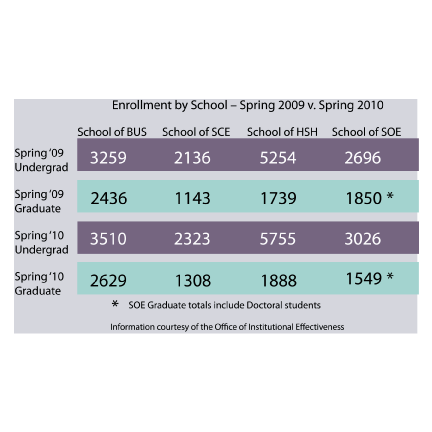Economy fails, enrollment sails
Terann Hilow
The Signal
Local colleges and universities have recorded record-breaking enrollments this semester. Students say a slow economy leads them in the direction of staying in or returning to school rather than searching for a job.
UHCL passed the 8,000 student enrollment mark for the first time in its history this semester. There are 8,111 students enrolled at UHCL this semester, surpassing last fall’s enrollment number of 7,643 students.
The UH main campus also broke its enrollment record this semester, recording 35,850 students and raising more than $100 million in private support. Meanwhile, UH-Downtown reported 12,579 attending students.
UH System Chancellor and UH President Renu Khator explained in an interview with the Bay Area Citizen that a greater number of students are listing the university as a top choice.
“We are emerging as a first-choice university for increasing numbers of excellent students,” Khator said.
A slow economy has led students to stay in school or go back to school for higher education in the hopes of obtaining greater job opportunities. Students working toward their bachelor’s and master’s degrees cite similar reasons for cracking the books versus hunting for a job.
“I would be willing to take a lower salary and a lot of hours if it was the right job and had good opportunities for advancement,” said Matt Crouch, UHCL accounting graduate student. “I have yet to find that, so I want to better myself while the economy remains terrible. It will cost a lot of money and be a lot of hard work, but a master’s degree these days get you a lot further than a bachelor’s degree.”
The U.S. Census Bureau reports that a college degree almost doubles the yearly earnings of workers. Workers 18 and older who have bachelors degrees will earn an average of $51,206, while those with a high school diploma will make $27,915. Workers with advanced degrees earn an average of $74,206.
“I went back to open up more opportunities in the job world,” said Ryan Mast, San Jacinto College student. “I’m good at sales, but without a degree you can only achieve a certain amount of success in that field. I had a window of opportunity to give school another shot so I jumped all over it.”
State Representative Ryan Guillen wrote on his blog, www.ryanguillen.com, that Texas colleges and universities are also seeing greater diversity among students, paired with higher enrollment numbers, which he partly attributes to legislation.
“Legislation offering a spot at any Texas public university to students who graduate in the top 10 percent of their class at public high schools has increased diversity at many college and universities,” Guillen wrote. “So many [students] chose UT that the legislature allowed it to take fewer top students, limiting guaranteed admission to the top 8 percent for the 2011-12 school year.”
Yvette Bendeck, associate vice president of enrollment management at UHCL, said that among the undergraduate degrees that are being pursued by students, the most popular are education, accounting, psychology, behavioral science, fitness and human performance, and biological sciences. For graduates, MBAs, psychology programs, educational management, computer science and counseling are most common.
Regarding growing job fields and opportunities for students looking at pursuing a degree with more secure opportunities, Roger Moncarz, projections economist for the Bureau of Labor Statistics, lets the numbers do the talking.
“Health care dominates the group of occupations right now,” Moncarz said. “It’s projected to be the fastest-growing group within the next 10 years. Seven out of the 10 fastest-growing job markets are related to health care, and that growth comes from an aging population.”
For further information about job statistics and projections, visit www.bls.gov.



Comments are closed, but trackbacks and pingbacks are open.